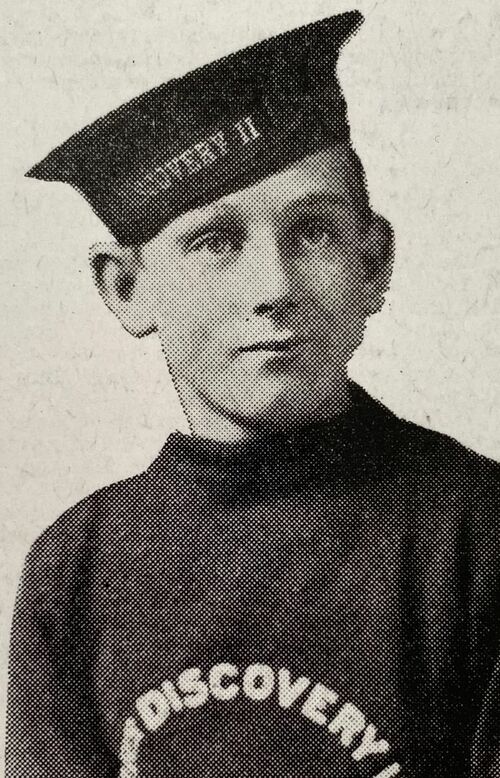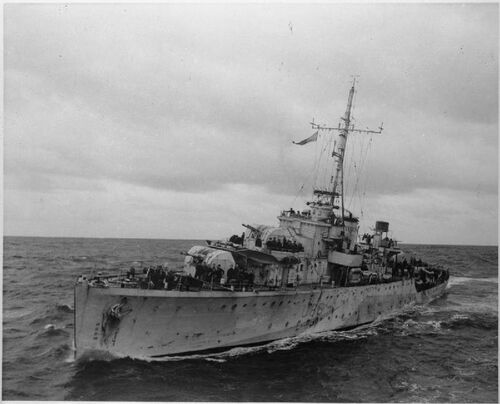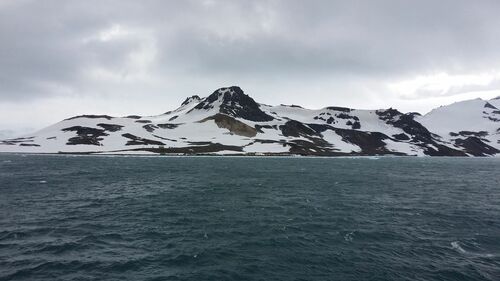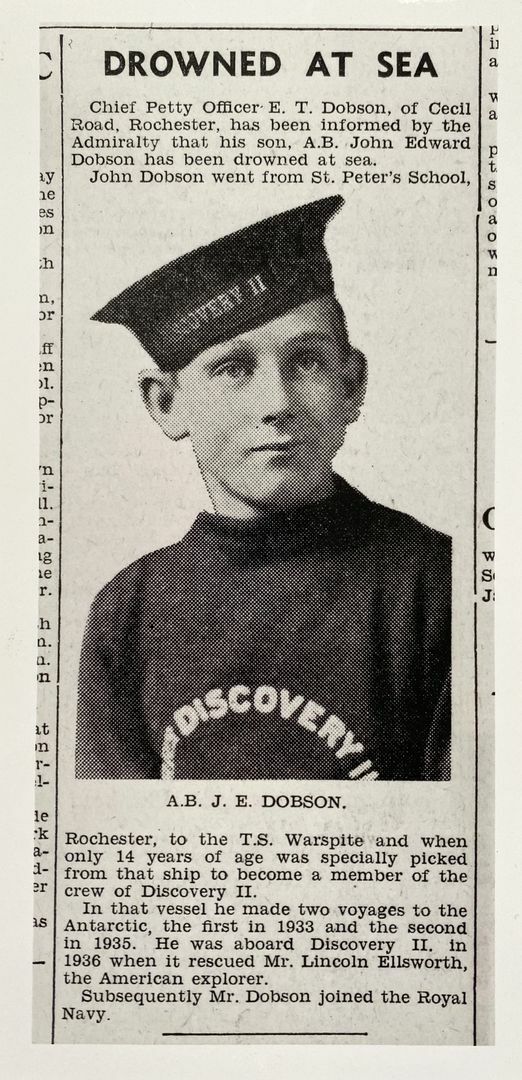Auction: 24001 - Orders, Decorations and Medals
Lot: 103
(x) The campaign group of four awarded to Able Seaman J. E. Dobson, Royal Navy; a veteran of two Antarctic expeditions, he survived the ordeal when the Rapid and her six-man crew became stranded without supplies when on a survey mission to King George Island in January 1937, being perhaps the youngest recipient of a Polar Medal
Dobson was just 21 years of age by the time of the Norway Campaign during the Second World War, he would be killed in action when the Pelican was dive bombed by enemy Ju-88s off Narvik
1939-45 Star; Atlantic Star; War Medal 1939-45; Polar Medal 1904, G.VI.R., bronze issue, 1 clasp, Antarctic 1933-37 (John Edward Dobson), good very fine (4)
John Edward Dobson was born on 18 June 1918 at 45 Castle Avenue, Rochester, the son of Petty Officer Edward Tremble Dobson, Royal Navy, and Alice Rose Dobson (nee Griggs). Educated at St Peter's School, Rochester and on the Training Ship Warspite where, when only 15, he was selected to be a member of the crew of the Royal Research Ship Discovery II. In that vessel he made two voyages to the Antarctic. On the first of these voyages (1933-35), lines of oceanographical observations were repeated at intervals in the meridian of 80°W and in the Scotia Sea, and visits were made to South Georgia, the South Orkney and South Shetland Islands. On 24 March 1934 Dobson was promoted Mess Boy and on 10 April 1934 advanced Able Seaman.
On the subsequent voyage a summer circumpolar oceanographical cruise was planned but the Discovery was diverted to the Bay of Whales to search for the missing Ameran explorer Mr Lincoln Ellsworth. After the rescue a revised programme saw lines of observations repeated at intervals across the Indian and Atlantic Sectors and work in the waters of the Falkland Island Dependences. Visits were made to the Balleny Islands, South Georgia, the South Orkney Islands and South Shetland Islands. On the 6 January 1937 Dobson was a member of the six-man survey party which set off from Discovery in the motor-boat Rapid for King George Island where they landed and set up camp. Whilst at sea the following day, their motor boat broke down and they were unable to return to camp. Adrift at the mercy of the sea, the motor-boat developed leaks and by 13 January the fuel for cooking and the food were running low. The six men (Chief Officer Richard Walker, third Engineer Robert G. Gourlay, Dr Francis D. Ommanney, Dr Strong, Bosun's mate John Matheson and Seaman Dobson) managed to make land and used the motor-boat's dinghy to make a crude shelter with a wall of snow bricks. Gourlay killed a seal with his knife to provide food for the party. They had no firearms. They were finally rescued by 18 January. It is interesting to note that the Ajax - latterly of 'River Plate' fame - went to assist in the search for Dobson and his comrades. In 1960, the Ajax Icefalls, found between Stenhouse Bluff and Ullmann Spur at the head of Visca Anchorage, King George Island were named in memory of its assistance in January 1937. (Discovery II in the Antarctic by J. Coleman Cooke, Chapter 14, 'Six men in a boat' & South Latitude by F. D. Ommanney, refers)
On his return from that voyage Dobson joined the Royal Navy. He volunteered on 30 June 1937 and was aboard Pelican by the outbreak of the Second World War. She was present during the campaign in Norway and came under heavy enemy attack on 22 April 1940. By this time Dobson was just 21 years of age.
This ship and her crew suffered perhaps the most serious damage and casualties of any Royal Navy ship that survived and then returned, after repair, to war service. An official Norwegian war history even describes her as bombed, split in two and sunk.
The official Admiralty Restricted Book of Reference 1886 (2) on “H.M. Ships Damaged or Sunk by Enemy Action 3rd Sept. 1939 to 2nd Sept. 1945” describes the damage:
‘(i) One Direct Hit 250 lbs. delay action fused Bomb.
(ii) Two Near Miss 250 lbs. direct action fused Bombs.
Time out of action: 7 months.
Brief Account of Damage and Lessons Learned:
Pelican was attacked by aircraft whilst proceeding off the Norwegian coast. The direct hit burst on impact with the quarter deck and exploded a number of depth charges stowed in the rails. As a result of the explosion the whole of the ship abaft ‘X’ mounting was destroyed. The near miss bombs caused severe splinter damage over a large area. Pelican was flooded from the plummer block compartments aft.
Fighting Efficiency:
Severely impaired. The vessel was immobilised and unseaworthy in rough weather. Half the ships armament was out of action.’
Further details of the crippling damage and casualties can be found in Commander Boswell’s report:
Damage Caused:
38. Four bombs were released simultaneously. One burst 100 feet Green from ‘X’ gun, splinters causing casualties to Upper Deck personnel from ‘B’ gun aft, and riddling the ship’s side.
39. Another bomb seems to have burst on the depth charges in one set of rails; there were 11 in one and 12 in the other touching side by side, besides the usual 8 standing by the throwers close by. All depth charges had primers inserted with pistols set to “safe”.
40. The explosion of the depth charges created a pressure wave, which disintegrated the ship abaft station 114, and worked forward until it met the strong structure of “Y” gun support and the gland space; here it seems to have blown away both sides and the bottom of the ship. Meanwhile the quarterdeck forward of station 114 was curled up over “Y” and “X” guns, the curl starting about station 95. The after bulkhead of the plummer block compartment was sound (station 94 below the Lower Deck), and the after bulkhead of the Ward Room (station 92 above the lower deck). There were no splinter marks visible on the turned up portion of the Quarter Deck.
41. Both propellor shafts were bent down, the starboard some 14 feet, and the port some 9 feet.
He confirms that '...one quarter of the ship’s company had been killed, and there were a large number of badly wounded'. So it was that Dobson was in the number killed. He is commemorated upon the Chatham Naval Memorial. In 1941, he was posthumously awarded the Polar Medal, being quite possibly the youngest recipient of this award.
Subject to 5% tax on Hammer Price in addition to 20% VAT on Buyer’s Premium.
Sold for
£6,500
Starting price
£2500













